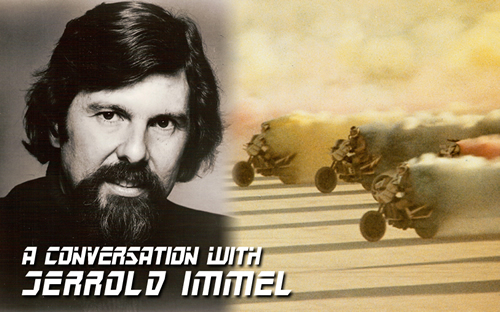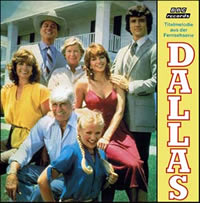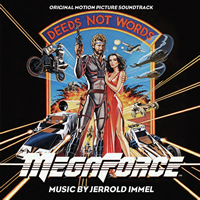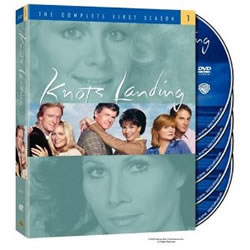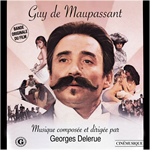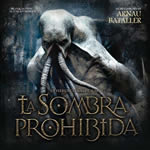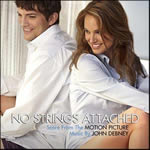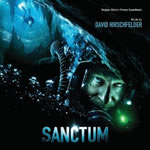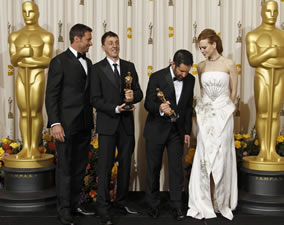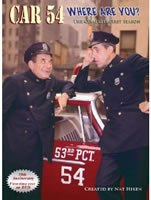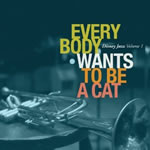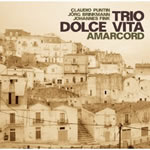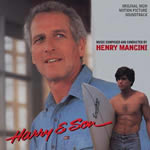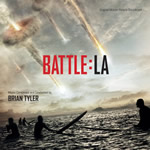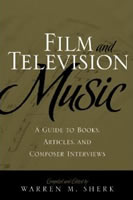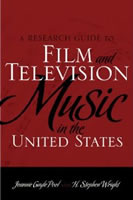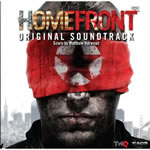
 |
Soundtrax: Episode 2011-02
February 28th, 2011By Randall D. Larson
Q: You’ve left an enduring legacy of music from your television work to the films that you’ve done. When most people think of Jerrold Immel they probably they think of DALLAS and KNOTS LANDING and things of that sort; they don’t realize there are a lot of feature films in there too.
Jerrold Immel: Yeah, there are a handful of feature films and several, maybe more than a handful of really good mini-series and things like that. A lot of Western stuff. THE SACKETTS, HOW THE WEST WAS WON. They’re all very melodic, that was a big part of my style, if I had a style! I mean, I had several styles, but they were all based pretty much on melodic writing.
Q: Your first feature film score was THE HOUSE ON SKULL MOUNTAIN (1974), a horror mystery. Coming as your first feature and relatively early in your career, do you recall your approach to that and how you created music to enhance the film’s horror and mystery components?
Jerrold Immel: I can remember that pretty well. It was an independent film that had no money, so my first job was to figure out how to come up with a score! That was in the very early days of synthesizers, and that would have been one way, of course, but I think the only synthesizer out at that time was a Moog or something like that. I may have used that a little bit, but primarily I used a Yamaha YC-30, an electronic organ, and not even digital. Clare Fisher had one and I rented his organ and he played it. I went for just a few unique sounds; I used three bassoons, maybe three flutes or flute/piccolos, another keyboard player, and two or three percussionists. I rented some unusual percussion instruments from Emil Richards’ collection. I just kind of blended eerie and unusual colors that I could come up with using this combination of things. I don’t remember it being very thematic, I think it was a score that relied a lot on colors and on orchestration. We had to record it at an incredible pace. I insisted in using union musicians, the good musicians that I was familiar with, and in order to use them and pay them I had to get it all done in something like seven hours of recording. I believe the film had over an hour of music in it.
Q: Did you find that your limitations in terms of budget and number of players tended to increase your being a little more creative and doing something unusual and distinctive here?
Jerrold Immel: Yeah, that’s very perceptive, and I think that’s definitely the case. You can’t go in – and I didn’t do it that much, anyway, going in with kind of a Jerry Immel formula for how to approach scoring. I felt every show would suggest to me what the orchestra should be and what the composing creativity should be, so I would take all those things into account, how much money I had to spend, how much time I had, what kind of an orchestra seemed to me would work well with that particular film.
Q: What’s your technique to come up with a TV theme? For example, when you needed to come up with a theme for DALLAS, what kind of creative process did you go through to come up with something that would be memorable and appropriate?
Jerrold Immel: DALLAS I can tell you fairly specifically. I was a little different each time. With DALLAS I didn’t find out that I was going to do the theme for that until it was well into production. It was originally a mini-series, and so when I was selected to be the composer, I got in touch with Leonard Katzman, who at that time was in Dallas while they were still in production on the film. I talked to him over the phone and I said, ‘what elements are you looking for in it?’ He said, ‘well, it’s got to be Western and it’s got to be urban.’ So I took those two key words and thought in terms of the spaciousness that I would usually put into Westerns at that time and the vernacular of Western scores, and then I hooked it together with what was sort of the driving dance stuff at the time, disco music. So I put together an orchestra that was very Western – lots of strings and horns, a rhythm section, a good sit-down drummer (this was before drum machines!), a guitar, sit-down bass, things like that. I had four or five musicians that gave me a rhythm section and put that disco beat down, and then I just layered the orchestra and came up with the main theme and then counter themes featuring the French horns. In structuring the score I referred a lot to the theme, and of course wrote many other themes for characters and situations and things like that. But DALLAS was a show where I could always use the Main Title. When I did the episodes, I could always refer to the Main Title and make constructions of it, and that was fun to do. [hear the DALLAS TV theme here]
Q: That’s something we don’t see as much these days, the theme is almost never used within the actual episode scoring.
Jerrold Immel: That is true. Styles were different, and that actually is dictated I think, to a large extent, in the way the shows are made. They’re made differently now….
Q: You also came up with a great – and very spacious - theme for the HOW THE WEST WAS WON TV show.
Jerrold Immel: That was an interesting project in that. It started with the fact that by the time GUNSMOKE wrapped up – I was the primary composer for GUNSMOKE in the last two or three years of its run –I was pretty worried about what I might be doing, because I wasn’t doing much else. I did an occasional episode of HAWAII FIVE-O and some other things for CBS. GUNSMOKE wrapped up in early 1975 and several of the people who were involved with it moved over to MGM to do this pilot, which was to be called THE MACAHANS. One of them was Jim Burns, who had done many, many episodes of GUNSMOKE and was an award-winning Western writer. Even James Arness, the star of GUNSMOKE, became the star of HOW THE WEST WAS WON. The executive producer was John Mantley, and they all just moved over to MGM and got this thing into production. I got word somewhere along the way either from Jim Burns or John Mantley that they were very interested in my doing the score for it, and I thought that would be great because here I am entering a tunnel where there may not be any work for me anymore, and so I thought maybe this is my opportunity to do something else. I had done a couple of other pilots at CBS prior to that, so HOW THE WEST WAS WON was my third pilot for television.
Anyway, when Mantley went to ABC and said “Jerrold Immel is going to be my composer,” ABC said no. “Nobody’s ever heard of him. This is going to be the biggest Western ever made for television, you have to go find a top feature film composer and hire him.” So I was heartbroken when I heard that, but that was the way it worked. So he hired Jerry Goldsmith and I went away on a trip to try to avoid suicide! When I came back my phone machine was full of messages from John Mantley saying “call me immediately!” So I called him as immediately as I could and he said “Jerry Goldsmith has a conflict and he has to do a feature score in London and has withdrawn from the picture. I went back to ABC and said you are my composer!” So that’s how it started, but what that also meant was that I had very, very little time to do that score. THE MACAHANS was a two-and-a-half hour pilot, and it had an hour and ten minutes of music in it – I had something like twenty-one days to come up with that entire score plus the theme. But, again, I had a wonderful orchestra – 48 musicians for much of it. I had a producer and writer who trusted me and said “just go for it. Use your assets!” So I studied all the great Western feature scores plus a lot of Aaron Copland, and just listened constantly for two or three days and saturated myself with those sounds. Then I just had to sit down and make it go. My orchestrator for that one is Bruce Broughton, who’s had a wonderful career in film. He and I were very close friends at CBS at the time; I was already out composing and he was still working as an executive at CBS, so it worked out well.
The other interesting story on that, because of the way the hiring had gone on it, John Mantley had really gone out on a limb because ABC was not crazy about the idea of my doing it. MGM didn’t know what to think, and the producer, Albert S. Ruddy, and I hadn’t met at that point. Harry Lojewski was the music director at MGM at the time and he would go out and have the orchestra sections play various chords so he could get a balance in the booth, so nobody had any idea while all of this was going on what this was going to sound like until we began recording. My wife was in the booth when we did the Main Title, which was the first thing we recorded. I was standing off to the side of the podium waiting for them to get all these balances and then finally Harry climbed down off the podium and handed me the baton, and he said ‘go to it!’ So I stood up there and gave the downbeat. It was not done to clicks in those days, I used to do mostly free conducting. They had all the speakers on – MGM had a huge booth inside with about six of these speakers that are taller than people – and the booth was packed with the producers ,the ABC people, the MGM people, and the Albert S. Ruddy people. As I said, my wife was in there and as soon as we started rehearsing to picture with the theme, she told me that Mantley just exploded off the ground, threw his fist in the air, and yelled to everybody ‘I told you so!’ Meanwhile I’m out there shaking not knowing that this was going on, and it was just a wonderful success! So instead of being the end my career that was really the beginning. [hear the MACAHANS/HOW THE WEST WAS WON theme here]
Q: Having proven yourself with that, did it get easier for you to get more and better assignments after that?
Jerrold Immel: It did, definitely. DALLAS came three or four years after that, but before DALLAS I had already done the mini-series of THE SACKETTS and other things that came off of this. I did two features for Albert S. Ruddy, MATHILDA and MEGAFORCE. So a lot of things came off. The other thing was, because of my melodic capabilities, I think, I got a lot of pilots. THE MACAHANS/HOW THE WEST WAS WON was my third, but I went on to do nearly forty pilots, and out of those forty I would say a third of them, roughly maybe thirteen or fourteen, went to series. Of the ones that went to series, DALLAS lasted thirteen years, KNOTS LANDING fourteen years, so I had some real longevity and of course that’s helping keep us alive now! But I just worked out so well.
Q: Do you recall how you got involved in MEGAFORCE?
Jerrold Immel: Yes. It was an Albert S. Ruddy production, and I had initially met Al Ruddy when I had done THE MACAHANS, and we formed a good relationship that lasted for several years. MEGAFORCE was the second feature that I did for Al Ruddy.
Q: When you got into that project, what kind of music were they asking for and what kind of approach seemed appropriate to you at the time?
Jerrold Immel: I thought of the movie as kind of a send up, and so I tried to treat it in that regard but also compose a serious military band score combined with electronics. I was given, I won’t say an unlimited budget, but they trusted me to spend the money in a way that they’d get something out of it. It was done at Evergreen Studios, and Armin Steiner was the mixer. I used an antiphonal approach with the orchestra, so it was a double band with several horns and trombones and trumpets and lots of woodwinds on each side of the stage, playing with all this percussion. It was kind of hard to hear in the final mix of the film. Anyway, the antiphonal orchestra was recorded separately and then I partnered up with Craig Huxley and we worked many days using a Synclavier, one of the early digital samplers, and created the electronic part of the score. I don’t remember the number of minutes there were in the entire score but it was pretty up there. It seemed like it was a pretty full soundtrack.
Q: What of the things I found unique, especially for 1982, is that this is one of the first scores that really uses a large amount of electronics mixed with an orchestra; prior to that it’s most been one or the other. What was your technique or your method of combining the two into on?
Jerrold Immel: It was a process of taking the 24-track recording that Armin came up with, with the antiphonal bands, and then Craig and I probably had two 24 tracks of the electronic music, and when they were blended we had a considerable mix-down session; it seems to me it was a couple of days of recording studio time. Armin and Craig both sat at the board and I stood behind them and said ‘a little more of this, a little less of this,’ and things like that to get the mix that I was after. And then I believe that went to the 3-track from there – or it might have gone to 6-track, I don’t remember exactly – and that went to the dubbing stage. And then of course as it always happens you lose some of the music, in this case probably quite a bit of it, to the sound effects because the director was very interested in preserving the sounds of the various war machines. So the music took somewhat of a back seat there. [For more details on Immel’s MEGAFORCE score, see my notes to the soundtrack album, just announced at: www.buysoundtrax.com ].
Q: You worked with Craig Huxley again on KNOTS LANDING…
Jerrold Immel: Yes, the last six or seven years of KNOTS LANDING. That was the period where more and more producers were looking for electronic scores. I had been connected to KNOTS LANDING – David Jacobs, who created that, produced it and everything, became a very good friend; he told me that he suggested me for the score because he heard something else that I had done on television and thought that I was the right guy. Once I did, he naturally had other projects that he wanted me to do and eventually I think I did probably about five or six series for David alone.
In fact I got a nomination for a score that I did for KNOTS LANDING that was all digital. I used four keyboard-synthesists, a percussionist, and a woodwind player who played the EWI [Electronic Wind Instrument]. That score was a very grim score – I went to the coldest colors I could find and found them with this, and that score got a nomination. Anyway, around 1987 the producers came to me and said “we would like to take the show into electronic music and we need to do smaller budgets.” So I formed a team then with Craig because he had the performance and programming skills, plus the Synclavier, and I had already worked with him on MEGAFORCE. So that became a logical partnership. In addition to KNOTS LANDING we went on to do other things – we did one feature film which was really awful [1987’s PROGRAMMED TO KILL], but we also did a show for Leonard Katzman, WALKER, TEXAS RANGER with Chuck Norris. That show was a deal between Chuck Norris and CBS – they had a partnership on it. Leonard Katzman was brought in because they were having trouble finding an identity with it, and he called me in [in Season 3, 1994] to do a new Main Title for it. So I took Craig with me on that, so he and I came up with a new theme and did the scores for several episodes. I believe John Parker also did some episodes, and also electronically; I only did it for half a season. Chuck Norris didn’t like anything that Katzman brought so he started out by firing the writers and then pretty soon he was firing the editors and eventually got to me. It wasn’t that he didn’t like the music, it was just that somebody suggested to him that he could sing a song and that would be the theme and he could make lots of money that way, so that was the end of my theme! And it was also the last thing that Craig and I did together.
Q: You composed at least one episode of the revived TWILIGHT ZONE in 1985. Do you recall anything about writing the music for that episode?
Jerrold Immel: I recall doing it but I can’t remember what I did with an orchestra or thematically. But I can confirm that I did it.
Q: You did a couple episodes of LOGAN’S RUN. What do you recall about working on that show?
Jerrold Immel: Yes I do, that one I remember better. That was 1977, so it would have been around the time that HOW THE WEST WAS WON was still going. I thought it was really a unique show to write for. Harry Lojewski had asked me to do it and I found out later that Leonard Katzman, again, was producing it, and this was before DALLAS. Anyway I agreed to do it. I admired the work of the composer who had done the main title [Laurence Rosenthal]. Harry Lojewski had suggested to me that it should be kind of a French impressionistic approach to it, so I did my due diligence and listened to a lot of Debussy and then tried to put what I knew about impressionistic writing to work with my usual approach of finding something thematic in that style. My two episodes were different from each other – my orchestrational approach in both cases was impressionistic, but the colors were very different. I enjoyed it very much and was happy doing it.
Q: Do you have any current music endeavors or are you fully retired now?
Jerrold Immel: I’m very much retired. I haven’t done anything since probably 1997.
_______________________________________________________________________________
New Soundtracks Releases of Note
THE BIG BUS/David Shire/FSM
David Shire, a quintessential 1970s action composer, has provided a quintessential mid’ 70s action score for this film, a 1976 Irwin Allen-esque disaster movie parody about a nuclear powered bus that meets disaster on its maiden cross-country trip. Like most successful parody film scores, Shire plays it straight as the disaster unfolds, supporting the film’s storyline and a rival maniac’s attempts to destroy it with deadly earnestness – and the occasional dramatic exaggeration, such as the arrangement of Strauss’ “Also Sprach Zarathustra” in reverence to 2001: A SPACE ODYSSEY as the bus (called Cyclops) is first seen emerging from its garage. The result is what is now a wonderfully retro action score for flailing rhythm section, disco drums, and a dazzling string melody that speaks Romantic Adventure in Capitol Clefs. And what’s a ‘70s disaster epic without a breathtaking love theme? Shire provides a classic romantic melody for syrupy strings underlined by low horns that is a real beaut. The action music that accompanies the bus’ high-speed maneuvers are backed by prominent disco beats is captivating and propulsive, occasionally diverting wildly to include one musical aside or another to fit with a humorous cut-away in contrast with the speeding action, culminating in the 5-minute-plus “Rescue” scene, which is played as originally written (re-cuts after scoring jarred the flow of the movie in the film’s release print), and flows into a gloriously riotous dissonance that amps up the suspense as Cyclops is rescued from its precarious position on a cliff overhand, with hugs of elation all around as Shire’s love theme is reprised before going into a final cheer of triumph from the main theme. Shire’s score music is offset by a quartet of source music cues heard during scenes aboard of luxury bus liner; I don’t have much use for all of that, but Shire’s score is a runaway winner.
THE EAGLE/ Atli Örvarsson/Silva Screen
Another film in the reawakened Gladiator subgenre, THE EAGLE tells of a young Roman soldier stationed to Roman-ruled Britain who seeks to find the lost golden emblem from his father’s lost legion. Örvarsson, having successfully migrated from television to big budget feature films with scores for VANTAGE POINT, BABYLON A.D., and SEASON OF THE WITCH, embodies THE EAGLE with a nicely textured score, some of it drawn from British folk traditions (“Tetsudo,” “Highlands,” the prolonged fiddle reel of “The Return of the Eagle,”) but most is a mix of orchestra and synths creating an period sound through rough, low musical timbres, which gives it a brooding, reflective appeal. The hollow sound of the zimbalom resonates lowly in “Honourable Discharge,” while a low solo Uilleann pipe intones mournfully in “May Your Souls Take Flight,” a somber and sorrowful paean for the dead before opening up with a lively surge of marcato strings suggesting the flight inherent in the cue’s title. “Barbarians” and “The Seal People” both offer up a brutal, rattling textures for exotic cultures, providing a distinct contrast with the music for “The Ninth Legion,” which is a majestic and honorable overture. “I Will Return” combines the poignant tonality of Uilleann pipes with full orchestra for an elegant reprise of the “Ninth Legion” motif. Another nicely textured track is “Better Angry Than Dead,” a very appealing interaction between large frame drums, ethnic winds, rattling percussion, surging horns, rhythmic cellos. Örvarsson has given the film a fine grain of evocative music, persuasive in both its timbral atmosphere and its melodic material. The score breathes with the ancient earth trod by the Legionaires, exudes the blood of savages and gladiators alike, and informs the protagonist’s passion to honor his father with a powerful emotive gravitas. A very good score. Silva will release this title in March in the US, on April 18th in the UK. See: www.silvascreenmusic.com
FILM MUSIC 2010/Silva Screen
The fourth installment in Silva Screen’s annual “Year Book” concept included 12 tracks from among the best themes from the last twelve months. Marvelously and faithfully interpreted for concert renditions by the City of Prague Philharmonic or the London Music Works, the compendium is a fine overview of last year’s greatest film music accomplishments, from A (Alexandre Desplat’s HARRY POTTER score) to Z (Hans Zimmer’s INCEPTION, given two tracks including “Time,” which many cite as among the year’s best cues). The only track to be given a make-over is “Recognizer” from Daft Punk’s TRON: LEGACY, originally achieved electronically, here given a fine orchestral interpretation which sizzles in all the right places and perhaps even adds an extra dynamic to its sonic palette. We also have Howard Shore’s eloquent romance from TWILIGHT: ECLIPSE, Ilan Eshkeri’s marvelously attractive them to the quirky super-hero actioner KICK-ASS, James Horner’s emotive “I Want To Go Home” from the remade KARATE KID, Ramin Djawadi’s poignant “Perseus” from CLASH OF THE TITANS, Danny Elfman’s lovely chorale theme for ALICE IN WONDERLAND, Brian Tyler’s vigorous main theme from THE EXPENDABLES, Michael Giacchino’s haunting end credits music from LET ME IN, and John Powell’s magnificent, rousing adventure cue “Forbidden Friend” from HOW TO TRAIN YOUR DRAGON. While all of these themes are available on their own soundtrack albums, Silva’s compilation makes for spectacular listening and a fine overview of some of the best of 2010.
GNOMEO & JULIET/James Newton Howard/Buena Vista
Disney’s distributor Buena Vista has released the soundtrack to this animated garden gnome romance, a rather engaging porcelain & crab grass take on Shakespeare, with four tracks of James Newton Howard’s underscore (about 20 mins.) but emphasis on the ten songs, all but two by Elton John, whose greatest hits à la 1972 occupy the bulk of the soundtrack on disc and in the film. The score takes most of its melodic intent from those same songs, leaving Howard with little to do except arrange some pleasing connective tissue between those instrumental tunes (“Dandelions” is made up of “Don’t Go Breaking My Heart,” both “Gnomeo and Juliet” and “Terrafirminator” riff on “Rocket Man, with some flair from “Saturday Night’s Aright (For Fighting) energizing the latter for the action-packed climax;” “Bennie and the Bunnies” is taken from… well, guess). It’s an okay score and Howard does an admirable job making exciting film music out of Elton John’s tunes (it’s actually a good fit, since Howard used to be in John’s band), but it’s not terribly interesting, since the recognizable tunes tend to distract by their familiarity; however the music is exciting and its quick-change pastiche style races all over the map like a, well, a cartoon score, which is fun. In addition to the John and score cues, Nelly Furtado does her take on “Crocodile Rock” and Thurl Ravenscroft provides a very funny version of “The Tiki, Tiki, Tiki Room” from Disneyland’s Enchanted Tiki Room. John provides a pair of pretty good new songs also.
GUY DE MAUPASSANT/Georges Delerue/Disques Cinémusique
This Canadian label has released the CD premiere of Delerue’s score for 1982’s biopic, GUY DE MAUPASSANT, a score which has never been reissued since its original Gaumont LP not ever been included on any of the composer’s many compilation albums. That’s odd because it’s a very fine score, and this release is essential for Delerue collectors and appreciators as it’s brimming with his trademark light classical, intricately melodious orchestral music. He recreates the mood of 19th century Paris through a lush variety of musical set-pieces – waltzes and polkas and the like, without a primary theme serving to characterize the character. Much of the music was designed to fit with various social gatherings the carefree French writer engaged in. But Delerue was a master at writing the loveliest of waltzes, and the film’s main title (“Generique”) is quite sumptuous in that regard; its melody is reprised in “Thème De Gisèle Final,” as close to a recurring motif the score will offer. “Valse de la dame en gris” (The Gray Lady Waltz) is another outstanding composition in Delerue’s finest form. There is a track called “Thème de Fanny” (Fanny’s Theme), occupied by a delicious melody, associated with one of the characters, but it is not circulated throughout the score. The score lasts a little more than 30 minutes, so the album is filled out with four tracks culled from an out-of-print compilation of Delerue film themes played by flute and guitar, a non-film flute and piano composition Delerue published in 1984 called Ballade Romantique, very much in his filmmusical style, and a new recording of “Fanny’s Theme” from GUY DE MAUPASSANT for oboe and flute over a small string ensemble.
LA HERENCIA VALDEMAR II: LA SOMBRA PROHIBIDA/Arnau Bataller/MovieScore Media
Arnau Bataller has created a horror score of truly epic romantic proportions with his two-part THE VALDEMAR LEGACY (2010; La Herencia Valdemar) and THE VALDEMAR LEGACY II: THE FORBIDDEN SHADOW (2011; A Herencia Valdemar Ii: La Sombra Prohibida). The first score was released by Samiel in Spain; MovieScore Media has provided the more powerful sequel score both digitally and on CD. In both scores, the composed conveys a splendidly sensitive and alluring melodic sound design that grows steadily darker and more Gothic as the story descends into mystical ceremonies and the summoning of a demonic entity of Lovecraftian proportions. THE FORBIDDEN SHADOW is drawn necessarily from thematic material introduced in the first movie, with sunken strains of fluid violins occasionally soaring into majestic grandeur of brass and choir, dappled by hollow gongs and distant percussion; the themes have been developed across both movies as past and present are linked by the legacy of what occurred in the Valdemar House, while musically linking past with present. But while the first film set up the storyline, the second unleashes the true horrors, and this added awakening of cosmic entities called for an especially vivid musical dynamic. Even so, the roots of the score are very firmly set in a 19th Century elegant romanticism, and even at its most powerful, the music is fluidly tonal, melodic, and utterly captivating. Unlike other musical approaches to Lovecraft which have often embraced the guttural darkness of pure electronica and industrial sound design, Bataller focuses on the period and the humanity of the tale, allowing the great tentacled horrors to threaten from the beyond, alluding to their awesome and terrible wonders while focusing on the characters and their emotional responses. That approach gives the music and its film a tremendously powerful resonance and an emotional affiliation with the audience that goes beyond mere terror, but embraces the humanity of the characters as they endure (or not) the cosmic horrors summon forth into the Valdemar House.
KILLZONE 3 (gamescore)/Joris de Man/Sony Computer Entertainment
Composer Joris de Man won the Ivor Novello award for best videogame score with KILLZONE 2, the first time the new category was included. KILLZONE 3 may likely win again. Released digitally through iTunes, the score is a massively epic score, as game scores tend to be, de Man’s music, powerfully recorded with orchestra and choir at London’s famous Abbey Road Studios, is a treasure. The music has an engaging main theme and enough majestic sweep to keep the shyest gamer forging ahead. The album’s 34 tracks are divided into 13 orchestral cues followed by several groups of electronic tracks associated with the game’s various environments. The electronic music is therefore fairly textural, some of it moving like fog to bring to life the grounds upon which the gamer trods, some reposing like a still life edifice, suggesting terrain and milieu, while the orchestral music is the adrenalin pumping through the first person shooter as he pursues and engages a variety of seemingly unstoppable foes. The dual elements, at least on the album, don’t merge and provide two distinct musical atmospheres, both of which are powerfully aggressive.
NO STRINGS ATTACHED/John Debney/Lakeshore
After a couple of heavy hitting action scores like IRON MAN II, PREDATORS, and MACHETE, John Debney returns to the world of the romantic comedy with this enticing composition. Ivan Reitman’s film has to do with a couple (Natalie Portman and Ashton Kutcher) who want to keep their relationship on a purely physical level (thus the title) but the inevitable complications keep getting in the way. The music is bright and cheerful, from the breezy opening with its hand claps and whistling melody over a happy mélange of guitars, mandolins, and drumkit to its hopeful and satisfying denouement as our heroes face a future together as more than casual bedmates. Much of the score is in the minimalist vein of, for lack of a better term, the Thomas Newmanesque approach which has been popular in contemporary comedies and romantic dramas since AMERICAN BEAUTY, and it works; it lays down a pleasing vibe using guitars and piano and light percussion that emphasizes the forward movement of the story, with a few occasional diversions into more active rock and pop riffs. Debney’s primary romantic melody, which doesn’t emerge until past midway in the film (which makes sense since the character’s affection doesn’t blossom until then either), and remains fairly wistful rather than emotively passionate – a more mature love theme than the soaring, flourishing rapturous love crescendos many films culminate with, which seems to fit the more mature development of the story as it plays out. It’s a pleasing score that maintains an appealing sound throughout.
SANCTUM/David Hirschfelder/Varese Sarabande
An adventure thriller about a life-threatening crisis during an underwater cave exploration that is surely not to appeal to claustrophobics, SANCTUM (sometimes inappropriately called JAMES CAMERON’S SANCTUM on account he is one of several producers on the film) features a fine orchestral score by David Hirschfelder (AUSTRALIA, LEGEND OF THE GUARDIANS: THE OWLS OF GA’HOOLE). The score opens with some ethnic voice music to set the scene and suggest the exotic appeal of “The Sacred Place” visited by the intrepid cave divers. “Espiritu Esa Ala” is a surging, glorious cue that brings the cast into the South Pacific Esa-ala caves, out of which Hirschfelder’s magnificent main theme emerges, broadly conveyed. The score underlines the awesome beauty of the underwater caving experience and maintains a similar tonal/melodic approach when the music turns dark and the floating cavers become trapped with diminishing oxygen in the bowels of the cave system; motifs and percussion effects introduced early on become haunting tonalities as the cavers become trapped and their outlook for survival becomes dim. The seven-minute long “Through the Restriction” drips with a fatalistic apprehension and a growing percussive sense of menacing doom. “The Sacred River” flows with an urgent fluctuation of horns over marcato strings, progressing to a surging climax; “What About Carl” seethes with a frantic energy through a propulsion of advancing string slashes, bridged by a bit of reflective, jangly, and shimmering percussion; the cue’s sensibility of mirrored in the more eloquently arranged “Down to a Sunless Sea,” resolving in the haunting percussion and voice reverberations of “Are We Home Yet?” as it exudes out of the dark depths into the cool comfort of the surface air. The album concludes with “The Sanctum Suite,” a likable six-minute reduction of the film’s primary attributes._______________________________________________________________________________
The Oscars
The Oscar for best original score went to Nine Inch Nails leader Trent Reznor and composer Atticus Ross (THE BOOK OF ELI) for their music to THE SOCIAL NETWORK. While I don’t mean to diminish their musical accomplishment which works so beautiful in that film, which is probably my favorite film of 2010 (and which David Fincher should have won the Best Director Oscar for, in my opinion), I felt musically John Powell’s HOW TO TRAIN YOUR DRAGON and Hans Zimmer’s INCEPTION were far more affecting and engaging film musical works. Those scores had more of a dramatic punch and were musically more interoperative with their films; while Reznor & Ross's score supported its film very appropriately I found the other two much more musically challenging and potent. THE SOCIAL NETWORK’S need for a score was effectively met by Reznor and Ross, who laid down a fairly subliminal sound pattern that wafted in and out of the film like fog, but it wasn’t really composed to the film. Powell’s music was cinematically adept, so well choreographed to the film’s changing tempos and rising and falling emotions and action, and Zimmer’s score was as intrinsically wedded to its film as was INCEPTION’s sound design (which did win the Oscar), giving the film an intensely powerful sonic impact that was at least a third of its storytelling potency. But we’ve seen it before. The Academy all too often seems to vote for trends or personalities or politics over musical merit, and true composers of film music are left out in the cold. Well, my hat’s off to Reznor and Ross all the same, their score was a fine one; but my sympathy to John Powell, whose first nomination really deserved to be recognized with a win, and to Hans Zimmer who despite his ubiquitousness in Hollywood movies composed a truly fine work of film music.
_______________________________________________________________________________
IFMCA Awards AnnouncedThe International Film Music Critics Association has announced the winners of its seventh annual awards for excellence in musical scoring in 2010 with John Powell’s score for the animated film HOW TO TRAIN YOUR DRAGON topping the list, winning both Film Score of the Year and Best Score for an Animated Film. Alexandre Desplat receives three awards: Best Score for a Drama Film (THE KING’S SPEECH), Best Score for an Action/Adventure/Thriller Film (THE GHOST WRITER) and Composer of the Year.
Continuing their tradition to highlight lesser known but vital world talents, the Association awards the Breakout Composer of the Year to Portuguese composer Nuno Malo for AMÁLIA. Turkish composer Pinar Toprak wins Best Score for a Comedy Film for her score to THE LIGHTKEEPERS. Rounding out the film categories are Best Score to a Fantasy/Science Fiction/Horror Film which goes to TRON: LEGACY by the French duo Daft Punk, Best Score for a Documentary Film winner is French composer Bruno Coulais for OCÉANS and American Danny Elfman’s “Alice Theme” from ALICE IN WONDERLAND wins Best Individual Composition.
In the non-film category, Bear McCreary wins his second award in a row in the Best Score for a Television Series, this year for Fox’s drama HUMAN TARGET (McCreary won last year for BATTLESTAR: GALACTICA). Kojima Productions’ CASTLEVANIA: LORDS OF SHADOW, with music by Óscar Araujo, wins Best Score for a Video Game or Interactive Media.
The Best Archival Release goes to the six-disc box set release of Alex North’s score to Stanley Kubrick’s SPARTACUS, which was Varèse Sarabande’s executive producer Robert Townson’s 1000th release for the label. Best Record Label of the Year goes La-La Land Records, their first win in this category, for such notable 2010 expanded release soundtracks as BATMAN RETURNS, DRAGONSLAYER, BEACH BLANKET BINGO and HOME ALONE.
The International Film Music Critics Association (IFMCA) is an association of online, print and radio journalists who specialize in writing about original film and television music. Since its inception in the late1990s, the IFMCA has grown to comprise over 50 members from countries as diverse as Australia, Belgium, Canada, Cyprus, France, Germany, Greece, Ireland, Italy, the Netherlands, Poland, Spain, Sweden, Switzerland, the United Kingdom, and the United States of America.
For complete list of winners and other information about the IFMCA, see: http://www.filmmusiccritics.org_______________________________________________________________________________
Soundtrack & Music News
Emmy-winning composer John Strauss died on February 14th at the age of 90. A composer and music editor best known for the jaunty theme music for the early 1960s TV show CAR 54, WHERE ARE YOU?, Strauss won an Emmy in 1978 for his work on THE AMAZING HOWARD HUGHES and a Grammy for his production work on the soundtrack album of AMADEUS. – via perseverancerecords.com
Three new compilations of Hammer horror film music will be made available through Silva Screen on March 28th. Released as part of The Hammer Legacy series, The Vampire Collection, The Frankenstein Collection and The Science Fiction Collection will feature some of the best music from the likes of Hammer composers Tristram Cary, Harry Robinson and James Bernard.
The downloadable soundtracks will be available through iTunes and other digital retailers.
http://www.hammerfilms.com/news/article/newsid/271/new-hammer-legacy-soundtracks-from-silva-screenAlexandre Desplat receives his first BAFTA Award for THE KING'S SPEECH. It is his first win in five nominations. His music for THE KING'S SPEECH continues to be recognized by film and music critics all over the world. Additionally, Desplat's score for THE GHOST WRITER was recently nominated for a César Award in France.
The Disney Pearl Series has released Disney Jazz Volume 1: Everybody Wants To Be A Cat, a 13-song collection of performances of Disney tunes by a white-gloved fistful of contemporary jazz stars and up-and-comers, including jazz legend Dave Brubeck. “I wanted to get a group of people together who would represent the many styles of jazz, such as getting The Bad Plus for an adventurous take, Regina Carter for a world music-oriented rendering, and Joshua Redman for a well-rounded sound,” said producer Jason Olaine. “We wanted to get the breadth and depth of what jazz is, as well as represent the generations of players, ranging from Dave Brubeck, who recorded a full album of Disney music, Dave Digs Disney, in 1957, to Nikki Yanofsky, who’s still a teenager.”
Speaking of jazz, the German label Jazzwerkstatt has released Amarcord by Trio Dolce Vita, a multi-instrumental trio that here performs nine tracks by Nino Rota, adapting his music for Fellini films and others, including THE GODFATHER, for the jazz trio. The result is a delightful interpretation of pristine Rota. Also of note is a very informative note from Fellini himself remembering Rota and how they worked together (it is presented in German, English, and French).
él Records has released a remastered edition of BEAT GIRL, a classic vintage British exploitation movie. The film owes much of its effectiveness to John Barry's impressive first film score – actually the first British original film soundtrack LP – with Vic Flick's savage twangy guitar presaging the Bond theme that was less than two years away. Beat Girl explores prostitution, juvenile delinquency, beatniks, jazz music, French women and coffee bars. It has no plot but a lot of energy and invention with the young Adam Faith the personification of cool sixteen year-old Gillian Hills perfect in the title role.
– via soundtrackcollector.com
Quartet Records presents a World Premiere Release for Henry Mancini’s HARRY AND SON, a 1984 drama directed by Paul Newman. This film marked the third collaboration between Newman and Mancini after SOMETIMES A GREAT NOTION (1970) and the TV movie THE SHADOW BOX (1980). A fourth collaboration between the two would follow in 1986 with the film adaptation of Tennessee William’s play The Glass Menagerie. “Henry Mancini’s score is utterly emotional, benefiting from a thrilling melody in jazz style… used as a leitmotiv to reflect the melancholy and solitude of both Harry (Newman) and his son Howie (Bobby Benson),” notes the label. “With less than 20 minutes of music in the film, it is thanks to MGM’s well-vaulted tapes with the original recording sessions that we have been able to discover an hour of music written by Mancini for the film, intended as both an underscore and source music, including many themes not included in the final cut.” Due to the original stereo mix being lost, Quartet Records has remixed each single cue out of the 2’’ 24 multi-tracks to include a number of alternate cues as well as a rare arrangement of the “Harry’s Theme” produced exclusive for promotional purposes. Limited to 1000 copies, the release Includes a 20-page booklet with many color stills and liner notes by Daniel Schweiger. The label has also just released limited 500-unit soundtracks to Giorgio Gaslini’s score for Michelangelo Antonioni´s LA NOTTE (1961) and Antonio Perez Olea’s score toJorge Grau’s first feature film, IL PECCATO (1962, aka Noche de verano).
Varese Sarabande will release soundtracks to Brian Tyler’s BATTLE: LOS ANGELES, John Ottman’s UNKNOWN, Patrick Doyle’s LA LIGNE DROITE on March 8th. Alexandre Desplat’s debonair action thriller sequel, LARGO WINCH II, comes along on March 22nd, and Chris Tilton’s TV score for FRINGE Season 2, Christopher Lennertz Easter parody HOP, and Jim Dooley’s TV music from PUSHING DAISIES, Season 2 all on April 5th.
Times Square Records, distributed by Silva Screen, will release Sufis At The Cinema on March 8th, a compilation of Sufi-influenced music from the Indian Cinema. Beginning with a classic from the 50s and progressing right through to the new millennium, the recordings – some blockbuster hits, others more rare – tell the true story of Sufi music in India and its influence on the more folklorish Qawwali, a music consumed on a daily basis, side-by-side with all other forms of popular Bollywood music. Sufi-influenced music has been present in Indian cinema pretty much since the first films were released. The relationship of Sufi music to the more popular Qawwali is almost similar to that of traditional Gospel music to traditional R&B music as pioneered by Ray Charles. The performances are not always 'pure' in the lyrical sense, but neither are they devoid of 'soul.' Whether following the popular conventions of the time, or striking out on their own, some of Bollywood's most impassioned and heartfelt performances are caught in these tracks.
_______________________________________________________________________________
Film Music Books
Scarecrow Press has released a pair of valuable film music research guides. Film and Television Music: A Guide to Books, Articles, and Composer Interviews, compiled and edited by Warren M. Sherk, archivist at the Academy of Motion Picture Arts and Sciences’ Margaret Herrick Library, is just what it says it is in its title – and is invaluable to anyone conducting movie music research or interested in seeking out articles, interviews, and the like that have appeared in all manner of publications from 1906 through 2005. Organized into eleven sections, including books on film and television music, academic dissertations, composer biographies, books with material on film and TV music, relevant periodicals, and the like. The 670-page tome also has a handy index that includes author and composer names, book and periodical titles, and some subjects like “collaboration,” “electronic music and scoring,” “songs for film,” and such. It’s an incredible valuable reference guide that I wish I would have had years ago when I started out writing about film composers. Naturally I immediately turned to the film music periodicals chapter and was pleased to find a thorough and accurate representation of CinemaScore, including a comprehensive overview of the publication both in its original newsletter format and in its large-sized magazine format. Similarly exhaustive indexes of Film Music Notebook, Film Score Monthly, Music from the Movies, Soundtrack Magazine and others are just as thorough – and all painstakingly indexed. Reasonably, the individual soundtrack reviews from magazines like this are not catalogued as that would take up a whole other book, and online publications are not included – and probably are not necessary in the age of Google. But to document what has been written about music for the movies for the last hundred years is a wealth of invaluable information to anyone conducting serious research or just seeking information for personal edification.
Equally significant if a far slimmer volume at 176 pages, A Research Guide to Film and Television Music in the United States by Jeannie Gayle Pool and H. Stephen Wright is focused not on what’s been written about film music but where to locate the actual written scores and other preserved relics of movie music. Pool and Wright, both veteran journalists and consultants in the field, provide individual chapters about silent and early sound film scores, understanding cue sheets, composer collections, library and archive collections of film music, and briefer summations of soundtrack recordings and film music literature. Along with Sherk, Pool and Wright are uncritical in their objective indexing and overviews of film music literature, giving fanzines and small press magazines equal standing with more scholarly tomes, focusing not on academic credentials but on content that would be significant to the research community. On its own, the two have collaborated on an important component of film music research – coupled with Sherk’s book, the two books (nicely published at the same time) are simply indispensible.
_______________________________________________________________________________
Games Music News
Sumthing Else Music Works has released the soundtrack to the Kaos Studiosfirst-person-shooter video game Homefront™. Composed by Matthew Harwood, whose previous game scores include Frontlines: Fuel of War, Homefrontis scheduled for release on March 8th to retail outlets and for digital download.
Set in the year 2027, Homefront delivers a gut-wrenching cinematic experience. Written by film director John Milius, parts of the American homeland are occupied by a savage far-east alliance driven by a nuclear-armed North Korean Army. In the aftermath of a crippling global energy crisis and a decade of economic and political turmoil, America has fallen. Its infrastructure shattered and military in disarray, the USA is powerless to resist the ever-expanding occupation. A once free people are now prisoners or collaborators or revolutionaries. The plot focuses on the story of a small resistance group amidst a larger set of events.
“Homefront is so rich and compelling that creating the score to support it was both rewarding and challenging,” said Harwood. “I would ask myself, how would I feel if this were to actually happen, how would I live, what would I do to protect my family, would I stand by and watch, or would I fight? The world of Homefront posed these questions to me in a way I was not initially expecting. Those questions were the cornerstone that I used to form an emotional compass for the compositions.”Describing the music for Homefront, Harwood explained: “Stylistically, the orchestra, which was fused with electronic elements that were supported by Asian percussion, was the brick and mortar. I also wanted to use guitars (both acoustic and electric) to help sell the locale. Asian instrumentation such as the erhu and pipa are heard to help mold the sonic quality. When we recorded the orchestra we did so in New York and it was a thrill to hear the score brought to life by the caliber musicians here in the city. To me, Homefront represents something rare in gaming, where the story and what it has to say are integral in the experience. Composing music for Homefront was a pleasure.”
For more information on Sumthing Else Music Works and its complete catalog of video game soundtracks, visit www.sumthing.com and www.sumthingdigital.com.
Randall D. Larson was for many years senior editor for Soundtrack Magazine, publisher of CinemaScore: The Film Music Journal, and a film music columnist for Cinefantastique magazine. A specialist on horror film music, he is the author of Musique Fantastique: A Survey of Film Music in the Fantastic Cinema and Music From the House of Hammer. He now writes for CinefantastiqueOnline and has written liner notes for more than 70 soundtrack CDs for such labels as La-La Land, Percepto, Perseverance, Harkit, and BSX Records. For more information, see: www.myspace.com/larsonrdl
Randall can be contacted at soundtraxrdl@gmail.com
